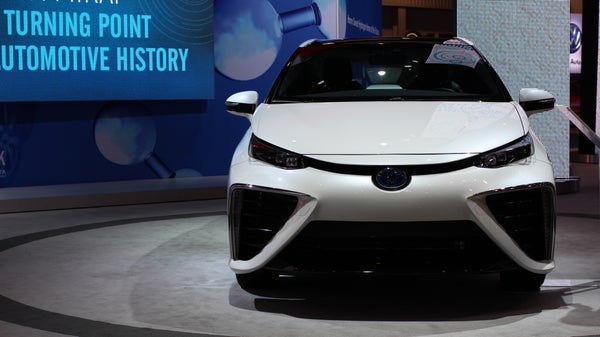Japan is betting big on hydrogen and wants the rest of the world to join in.
In March, the country’s Ministry of Economy, Trade and Industry set a target of 40,000 hydrogen fuel-cell vehicles on its roads by 2020 and 160 fueling stations, up from the 80 hydrogen stations operating right now. The agency also set an 800,000 yen ($8,000) price target for household polymer electrolyte fuel cells by 2019.
The private sector is chipping in, as well. Japanese auto giant Toyota released the Mirai, the company’s first commercial fuel-cell-powered car, in 2014. Fuel cells turn hydrogen gas into electricity, which in turn drives an electric motor.
On supporting science journalism
If you're enjoying this article, consider supporting our award-winning journalism by subscribing. By purchasing a subscription you are helping to ensure the future of impactful stories about the discoveries and ideas shaping our world today.
Earlier this year, Kawasaki Heavy Industries Ltd. and Iwatani Corp. partnered with Kobe city to build a 10 billion yen ($84 million) liquefied hydrogen import hub. The project, due to go online in 2020, will import hydrogen made from lignite coal in Australia.
The hydrogen push is a strategic and practical bet for a resource-strapped island nation. Though nations like China are investing heavily in batteries for vehicles and on the grid, hydrogen has some promising economic and environmental advantages for Japan.
“Hydrogen is attracting attention as an energy source that can solve problems such as global warming and depletion of energy resources,” said Kazuo Furukawa, chairman of the New Energy and Industrial Technology Development Organization (NEDO). “Abundant. Clean. Flexible.”
He spoke last month at the Woodrow Wilson International Center for Scholars in Washington, D.C., to outline the case for creating a “hydrogen society.”
“A hydrogen society is where hydrogen is readily available for us,” Furukawa said. In addition to fueling cars, hydrogen could provide household backup power and store excess wind and solar power on the grid.
Getting a head start?
But this would require cheap sources of hydrogen, whether it’s electrolyzing water with renewable energy or gasifying lignite coal.
The system would demand pipelines and shipping methods to transport hydrogen and then fueling stations to distribute it to end users like cars, households and industries. Driving the costs of this infrastructure down far enough to compete with fossil fuels would depend on a global economy of scale, and many countries would have to buy in.
“For this reason, cooperation with other countries is very important,” Furukawa said. “Global warming cannot be fixed by any one country.”
The economic upside for Japan may be substantial, as well, as the country struggles with a national debt that has ballooned to 240 percent of its gross domestic product.
“There is an incentive for nations to have a unique, differentiated approach and push the rest of the world to adopt,” said Cosmin Laslau, a senior analyst at Lux Research, a market analysis firm. For Japan, moving early and aggressively in hydrogen could give its industries an edge as the world plays catch-up.
“These companies are world-class, and if they put their weight behind the technology, that has a very positive impact on growth,” Laslau added.
Policies, incentives play key role
Though fuel cells have made tremendous strides in driving down costs, using fewer precious metal catalysts and more efficient components, fuel-cell-powered cars still have a higher entry price tag. The Toyota Mirai starts at $57,000, while Nissan’s all-electric Leaf starts at $29,000.
The upsides of longer range and faster fueling may not be enough to bridge the price gap for early adopters, Laslau observed.
And while improved technology can fill part of the price gap, the remainder depends on manufacturers and suppliers following Japan’s lead, building up supply chains to support fuel cells on an international scale.
“If [manufacturers] were able to scale up and sell a million vehicles, the price would come way, way down,” said Christopher San Marchi, manager of the hydrogen program at Sandia National Laboratories. “We have not started reaching economies of scale yet.”
Governments can speed up the process through targets, incentives and regulations, San Marchi observed, noting that states like California also have mandates for zero-carbon-emissions vehicles that include fuel cells.
Policies can also help resolve the chicken-or-the-egg dilemma of whether building hydrogen fueling stations will convince more people to buy fuel-cell-powered cars or vice versa.
Nonetheless, both batteries and hydrogen fuel cells may find niches in vehicles and on the power grid over the coming years. “It’s not an either-or,” he said “They’re complementary in many ways.”
Reprinted from Climatewire with permission from Environment & Energy Publishing, LLC. www.eenews.net, 202-628-6500
